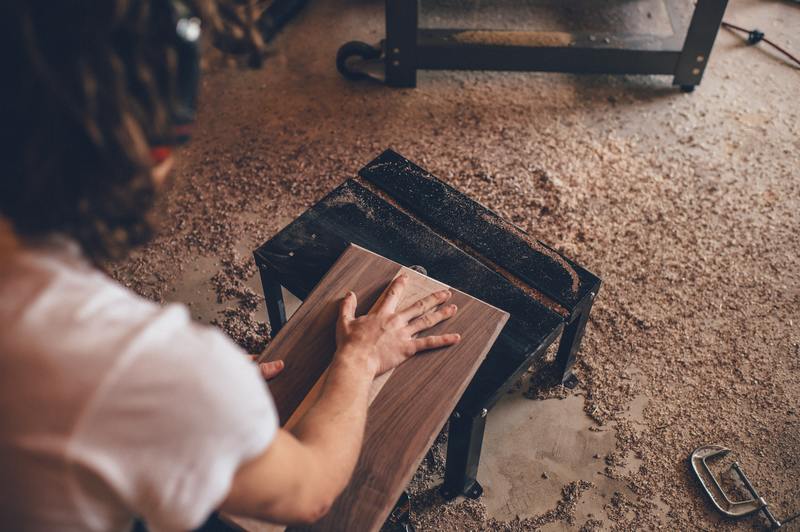We’re all curious about what is white powdery residue on water damaged wood. Thus, few things are more aggravating than investing time, money, and effort into maintaining your home in great shape, only to discover white residue in your wood floors, furniture, and ceilings one day. This article will get through all the facts you need to know about white molds on water-damaged wood!

What Is White Mold?
White mold is a general term for a variety of mold species that seem white. Penicillium, Aspergillus, and Cladosporium are the most prevalent species discovered in homes.
These molds can come in various colors, including gray, green, black, and other shades. Furthermore, all molds flourish in damp environments with a food source, such as wood.
In most cases, determining the type of mold in your home is unnecessary because all molds have the same detrimental consequences. In their early phases of development, some molds may seem white.
After generating spores, some molds may change color. However, because their spores are not colored, many molds appear white regardless of age.
The lack of spore coloration is due to the type of material on which it is developing. Furthermore, white mold appears powdery and may mix with the materials it grows on, making it difficult to distinguish between mold and other contaminants.
What does white mold look like?
Since the spores are so tiny, white molds are difficult to identify when they initially appear. White molds will show as white dots on a surface once the colonies have formed.
In nature, the patches might be powdery and filmy. Although it may appear like mildew at first glance, white mold is more dangerous since it can grow within organic things rather than only on the surface.
White Mold Vs. Mildew And Efflorescence
People frequently confuse white mold with mildew, which can also seem white. On the other hand, mildew rarely grows on surfaces other than plants and does not cause material degradation. White mold can destroy porous materials like wood or drywall by penetrating their surface.
People frequently confuse white mold with a material known as efflorescence. Salt deposits form when salty water penetrates through concrete, brick, or stone. When the water evaporates, a white crystalline material similar to mold is left behind.
Efflorescence, unlike white mold, does not represent a health risk and does not grow or spread. Examine the afflicted surface to determine whether a substance is a white mold or efflorescence. It’s efflorescence if it’s masonry.
Put some of it in a drop of water and see if it dissolves; if it does, it’s not mold. Finally, squeeze some of the items between your fingers to see if it breaks down into a fine powder.
What causes white mold?
White mold has the exact cause as other varieties of mold. Mold needs two things to thrive: a moist habitat and food.
Leaks or poorly ventilated rooms are frequently the sources of moisture. Wood, drywall, carpets, and other organic materials are familiar food sources. The best way to deal with this is to learn how to clean water damaged bare wood and other materials — preferably with a bleach and water solution.
Is white mold dangerous?
The final line is that the health concerns associated with white mold are highly dependent on the individual. Some people are unaffected by the spores, while others are allergic to them. Sneezing, a rash on the skin, and a runny nose are all symptoms of allergies.
The consequences can be more significant and dangerous if your immune system is impaired. If you feel that you or a family member has been exposed to white mold for an extended time, you should always seek medical advice.
Where is white mold most common in homes?
Mold thrives in dark, damp settings where there is a food source.
Basements
White mold commonly grows on concrete walls, wooden floor joists, and items stored in basements, such as clothing. Water seeps through basement walls, resulting in a wet atmosphere that promotes mold growth. Condensation can occur when cold outside air meets warm indoor air in basements, making white mold an ideal breeding habitat.
Attics
As they include many food sources like wood and insulation, attics are ideal for white mold growth. Mold can be fed moisture through leaking roofs, condensation from changing temperatures, leaking pipes, and inadequate ventilation.
Because of the confined confines, removing mold from attics can be extremely difficult. We recommend examining your attic for white mold or a musty odor regularly.
Crawlspaces
White mold is most likely to be found in crawl spaces, such as basements, in your home. Mold in crawl spaces can be caused by leaking pipes, broken downspouts or gutters, foundation fractures, insufficient ventilation, and other sources of moisture.
It’s also advisable not to store anything in your crawl space because mold loves cardboard cartons and other organic stuff. As previously stated, when removing and remediating mold, you must also address the source of moisture.
Conclusion
White mold can grow on porous materials like wood, sheetrock, and furniture. They can also grow on wood surfaces such as rafters in the attic, floor joists in the basement or crawl spaces, and wooden furniture.
Hopefully, we have provided you with the most accurate answers to your queries on what is white powdery residue on water damaged wood. You can use these details to take care of the problem as soon as you can.
